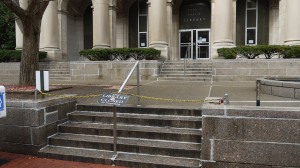- Like
- Digg
- Del
- Tumblr
- VKontakte
- Buffer
- Love This
- Odnoklassniki
- Meneame
- Blogger
- Amazon
- Yahoo Mail
- Gmail
- AOL
- Newsvine
- HackerNews
- Evernote
- MySpace
- Mail.ru
- Viadeo
- Line
- Comments
- Yummly
- SMS
- Viber
- Telegram
- Subscribe
- Skype
- Facebook Messenger
- Kakao
- LiveJournal
- Yammer
- Edgar
- Fintel
- Mix
- Instapaper
- Copy Link
Re: Nine-county water-use ban due to Freedom Industries chemical spill into the Elk River
Statement from Janet Keating, executive director of the Huntington, W.Va.-based Ohio Valley Environmental Coalition:
The Ohio Valley Environmental Coalition (OVEC) extends its concern to people and communities impacted by yesterday’s release of 4-methylcyclohexane methanol. More than a day and a half after people first noticed the odor that alerted officials to the leak, the smell still lingers near downtown Charleston, though, due to health-department-ordered shutdown of restaurants, there are few people downtown.

On Friday, Jan. 10, 2014 at 12:30 p.m., Capitol Street in downtown Charleston is nearly deserted. Normally, at the lunch hour, the street would be crowded.
Photo by Vivian Stockman
There appear to be more questions than answers surrounding this event, especially regarding potential health concerns.
For more than 24 hours, West Virginia American Water Company customers in nine counties have not been able to use their water, except to flush toilets.
This scary and broad-scale emergency focuses our thoughts on the vulnerability of our water supply, especially as it relates to energy development. We hope our state leaders realize that clean water can not be taken for granted and needs to be actively protected. Water is not only vital to all life, but also necessary for a fully functioning economy.
With many shuttered restaurants and other businesses across the nine-county area, undoubtedly West Virginia’s economy has taken a hit and our citizens have been inconvenienced as they have searched out clean, potable water.

We will continue to monitor this serious situation and invite citizens to express their concerns to all elected leaders about the need to protect our precious and vital water resources.

Libraries, day care centers, schools, hair salons, bars are among the businesses and institutions closed. Hospitals have cancelled scheduled procedures.










THere should be an immediate shut-down of water withdrawals for the fracking business. Clean drinking water is needed for people!
Also, we invite friends of OVEC in the affected southern counties to come to our farm(s) in Doddridge County. We have warmth, beds, food and water. Also music!
Hi Suz.
This emergency has really underscored the need to protect West Virginia’s water from pollution cause by mining as well as fracking. It is rather foolish that 300,000 people are dependent on a single drinking-water source. Time was when people could drink water from their streams and wells. Nowadays, sadly, that is not the case in many places throughout the state. Withdrawing water to use in the fracking process is at best, a bad use of a precious and dwindling resource. Our state and national leaders need to get serious about transitioning our economy away from dirty energy sources and moving towards clean, renewable energy.
Thanks for offering your place to stay–the warmth and generosity of so many people like you–is what makes West Virginia the special place that it is!
Why do the articles on this spill not mention anything about treating the contaminated water? Doesn’t superchlorination destroy this organics; or could activated charcoal be used to absorb the chemical? Water treatment plants do these things routinely. Most organic chemicals can be removed from water.
Hi Mr. Byrnes.
I will try to answer your question. It is my understanding that WV American Water has had no previous experience dealing with this chemical–4-methylcyclohexanemethanol. No one even knew (knows) what a safe level of human exposure might be. Take a look at this article to see how the buck is getting passed around state government, WV Water, Freedom Industries, OSHA, WV DEP, etc.. http://www.wvgazette.com/News/201401110085?page=2
A second article in the Sunday Gazette-Mail, shows how clueless everyone seems to be. You can read it here: http://www.wvgazette.com/News/201401110061 The powers that be have come up with 1 ppm as the magical safe number regarding just when the water will be safe to drink, etc.
I have to wonder, as other folks have pointed out, whether or not there would be a water crisis at all if this compound didn’t have such a strong odor. I know that’s cynical…
The head of WV American Water has said that they, the company, have no way of removing it. They are continuing to test the water and plan to flush the system once the chemical is at or below 1 part per million. I would have thought, in the very least, that water suppliers would anticipated how to deal with an organic chemical release.
I just found another explanation about the use of activated charcoal to clean the water. This is from a National Geographic news story:
“McIntyre said his utility’s water treatment plant “is designed to handle such events,” although he explained that no water plant is designed to specifically treat every possible chemical: “They are designed to treat things that are naturally in the water stream.”
McIntyre added that the treatment plant has “a premium treatment process,” a filter of activated carbon that sits ready in case of a potentially dangerous discharge. In this case, however, “the carbon got saturated with that material and therefore the treatment process couldn’t handle the quantity.”
In other words, there was so much 4-methylcyclohexane methanol in the water that much of it was flowing past the carbon filter and into the water supply.”
I hope that answers your thoughtful question.
More questions that comes to mind is, what system are they flushing the fouled water into? What monitoring or filtering is in place at that stage of the process?
Hi Ms. Anderson.
Yours is a thoughtful question. Since I’m no expert on the treatment of sewage, I checked out this link from the US Geological Survey: http://ga.water.usgs.gov/edu/wwvisit.html
All the water that was flushed from homes, schools, businesses, etc., went to some waste water treatment facility somewhere. Most are adjacent to waterways. After undergoing various phases of treatment, the “treated” water is released into a river in most cases. Where I live, treated waste water goes into the Ohio River, and becomes water for someone else’s use downstream. We “trust” that the really toxic chemicals have been removed.